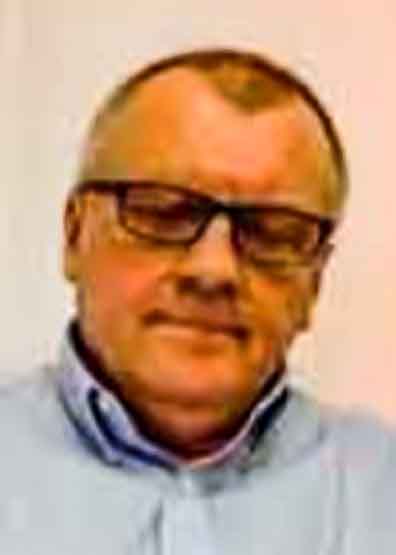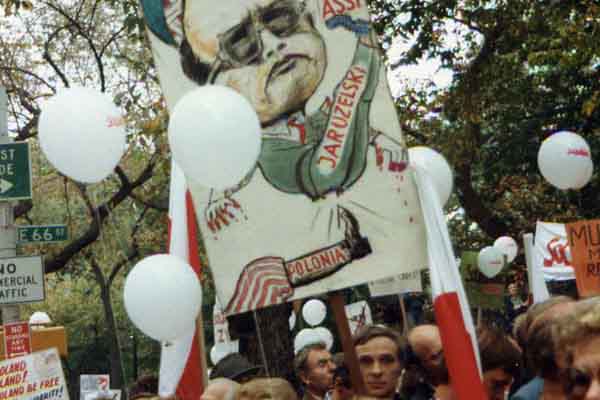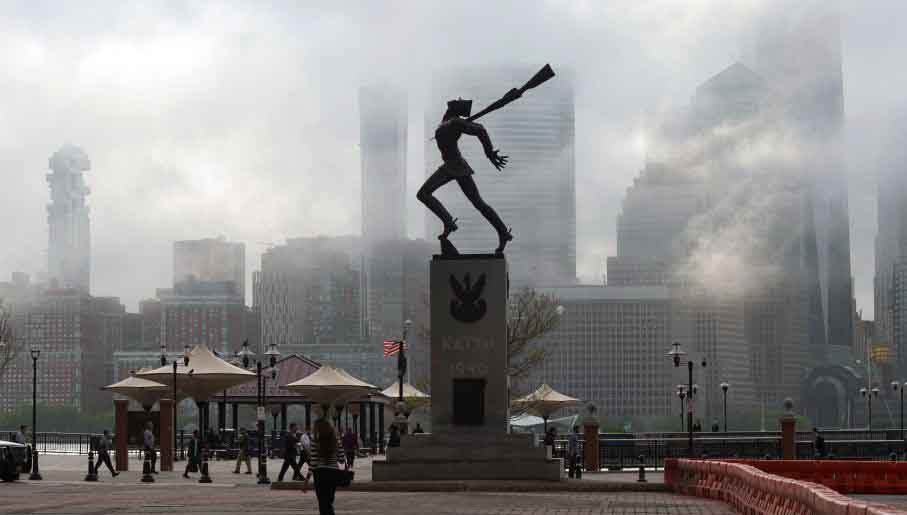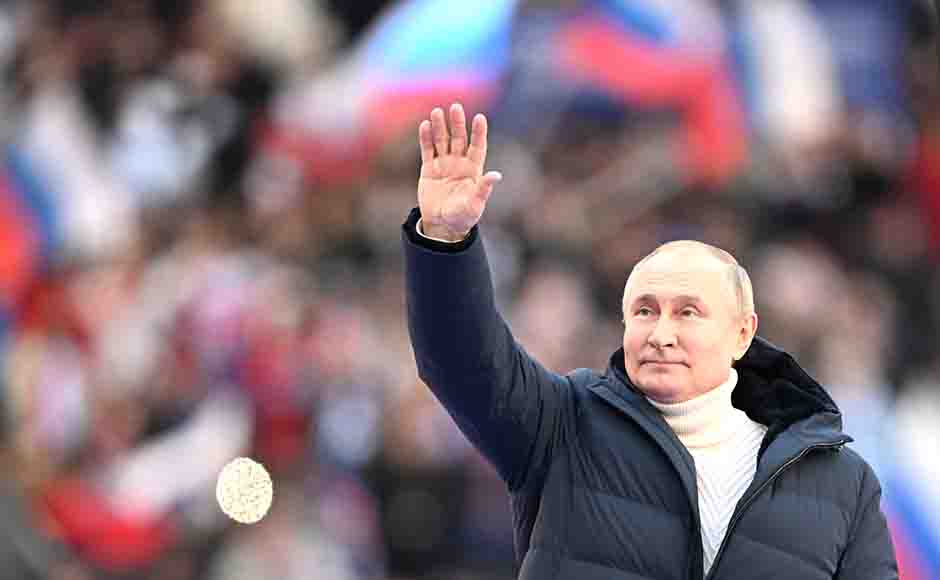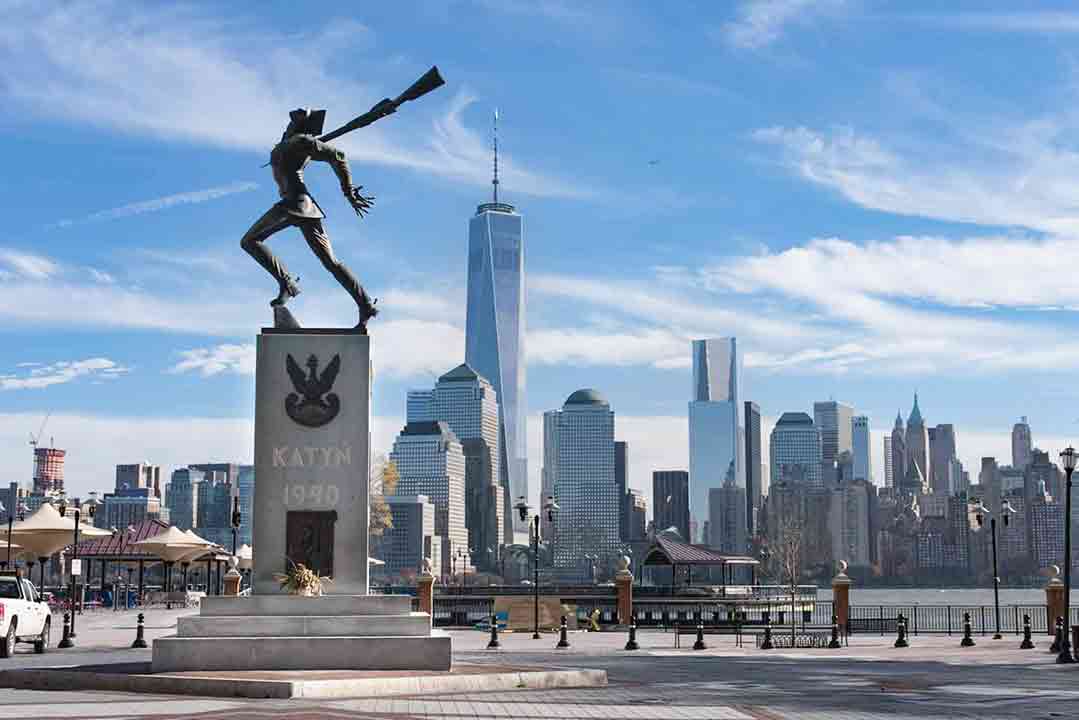Editor Marek Bober interviewed Wojciech Stan Mazur, vice-president for business affairs of the Committee for the Protection of the Katyn Monument and Historical Objects (Komitet Ochrony Pomnika Katyńskiego i Obiektów Historycznych, KOPKiOH), a businessman, an anti-communist opposition activist in the times of the People's Republic of Poland, who currently lives in Connecticut.
Marek Bober: At the beginning of 2022, information came from Jersey City that the square where the Katyn Monument by Andrzej Pityński stands, Exchange Place, will be redeveloped. These plans, according to the visualizations, were to limit the visibility of the monument as well as access to it. What were the original assumptions?
Wojciech Stan Mazur: Everyone was surprised by the changes in the plans, but the process was not completed and it was not carried out differently than in the case of the previous two proposed changes. We were always presented with plans for consultation and our suggestions were taken into account, or not. In this case, the difference was that the plans presented in April 2022 were regressive. High benches were placed around the 5-foot tall monument and trees in the immediate vicinity of the monument. These two changes surprised us, but they were not final as the talks process continued and our constructive proposals were listened to.
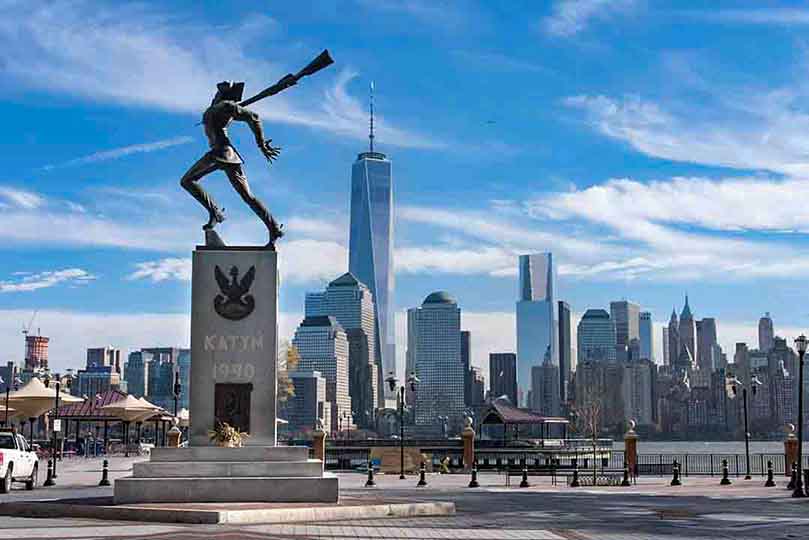
The Katyn Monument in Jersey City (Source: Facebook)
In May, at a meeting of councilors at Jersey City City Hall and on Zoom for planners, I presented our (Committee for the Protection of the Katyn Monument and Historical Objects, KOPKiOH) proposals to replace the high bench that surrounded the monument with two rows of the same benches on the sides of the monument, exposing it and creating a second access to the monument from the city side. Celebrations always take place from this side. At the same time, being constructive and meeting the tasks of ecological organizations, we agreed to keep the trees, because they do not cover the monument either from the side of the Hudson River or from the side of the city.
MB: Were the fears of a large part of the Polish community, mainly from the East Coast, justified? The announcements of changes at Exchange Place were very radical. Polonia had a bad experience with the authorities of Jersey City a few years ago, when the monument was in danger of being moved...
WSM: Their concerns were not specific because they did not form any united front or organization. They protested on May 10 at a meeting of the city's planning office on Zoom, and each person voiced different demands. From this meeting, it is possible to single out only one common denominator, which was to stop any plans and works for the reconstruction of the square. Many of the speeches were not well prepared, understandable, and did not even fit into the 3 minutes allotted for each person. As I mentioned, on behalf of KOPKiOH, I put forward our proposals and we gained the support of several people who were not members of the committee. The planning office decided to stop the design work.
Everyone's hopes were dashed when, at the next meeting, the planning office reversed its decision because they had signed a master plan with a group of planners from the Exchange Place Alliance. They simply exceeded their competence by breaking the agreement, i.e. by stopping the planning. It wasn't a victory, or at least it should have mobilized opponents of square planning to do some concrete work or develop a strategy.
Unfortunately, they were unable to communicate, organize protests, meet councilors or planners for any talks. They were not even able to organize themselves around the strategy of Sławek Platta, which was presented by the so-called initiative group. Ms. Piórkowska made prohibitive demands and the whole initiative, which was also supported by the Committee for the Protection of the Monument, fell apart in the run-up to the meeting. All the steam on the whistle and, as usual, a flop — colloquially speaking.
Pushing out Sławek, Platta has moved the discourse, but without the Monument Protection Committee, because we stayed with Sławek's plan, in the direction of a lawsuit, depriving ourselves of the person who considered a pro bono lawsuit as a last step in the plan.
It should be recalled here that in 2018, Sławek Platta successfully launched a case by blocking any works aimed at removing the monument, giving the Polish community time to protest and win the petition for a referendum. The oversized egos of some people and their desire to shine led to the fact that the whole lawsuit means nothing to the changes in the design of the square, and only the Committee for the Protection of the Monument led to changes and a satisfactory compromise.
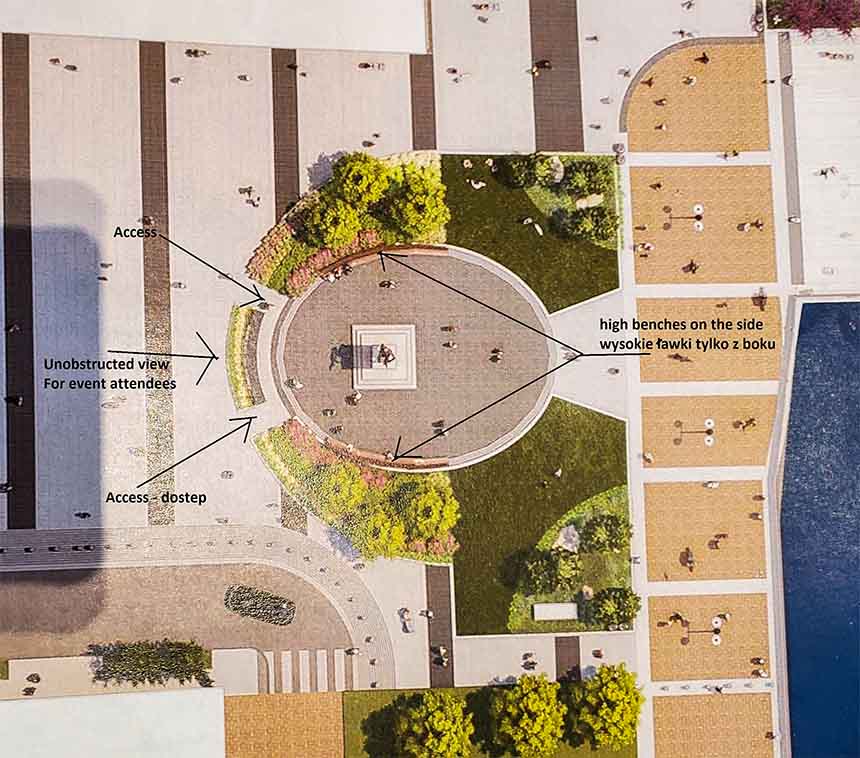
The visualization of the monument in Jersey City. Final plans with access from the city and reduced benches. (Source: KOPKiOH)
MB: In my opinion, the indignation, or rather anxiety, of part of the Polish community about the future of the monument was justified. It got to the point that this uneasiness was concreteized by the threat of a lawsuit to stop the city's plans. The initiative was taken by the organization you founded, the Polish American Strategic Initiative (PASI). How is the situation today?
WSM: Being a co-founder of PASI and a major contributor to the group's development and lobbying, I wrote the organization's charter, co-organized demonstrations and lobbying on Capitol Hill, and got people like Norman Finkelstein and Congressman Jim Himes to speak out on Bill S447. On Katyn Resolution S566, together with Alicja Woźniak, I led to a meeting with key employees of Senator Menendez's office, and in the last election I received a positive response to a meeting with PASI from Connecticut governor's candidate Bob Stefanowski. On my initiative, we were to talk to Bob Stefanowski about his program and the place of the Polish community in his work if he becomes governor of Connecticut. Unfortunately, there was no interest in this within the executive committee, PASI seized to be an organization lobbying on behalf of Polonia and Polish national interests.
From 2020, I kept the board informed on the progress of negotiations on the monument until the sad May 2022, when I resigned from the position of vice president. Everyone knew that the planning issue was under control, and yet the president, under pressure from his secretary, entered into a lawsuit to completely cancel any plans to redevelop Exchange Place. This was done in a very unclear way, because the vote was postponed twice for different reasons. I warned them that this lawsuit has no legal basis and I presented it already in January 2022, when I got acquainted with it.
The inaccuracies contained in the lawsuit are as follows:
- The City Council, along with Mayor Steven Fulop, signed the appropriate agreements with planners from the Exchange Place Alliance in compliance with applicable laws and building codes.
- Access to the hotels has always been guaranteed and has been maintained in the plans.
As for the monument, we cannot demand much from the planners if it is not recognized as a landmark. Everything that is done around it is in accordance with the regulations that define it as an ordinary building structure. As for Andrzej Pityński's vision and his last will, which were also supposed to be the reason for the suspension of work, there is no last will regarding this monument, and the artist's vision is summed up in the statement he expressed in 2018, agreeing to move the monument on the condition that it will be on the Hudson waterfront, visible from the river and against the backdrop of Manhattan skyscrapers. So there is generally no reason to stop the works. In 2018, we ensured that it stands in a prestigious place, and now we have guaranteed, through our lobbying and consultations, that it is visible, accessible and beautifully highlighted by the surroundings.
This lawsuit is sterile and did not stop the work, but it divided Polonia. Worst of all, in such an important election year, the attention of American Polonia was completely shifted away from the issues of elections and absorbed in the artificial problem of the alleged "threat to the monument".
In these elections, no new Polish representative or candidate of Polish descent was promoted by Polish organizations, let alone elected to any office. Energy and opportunities to improve this dramatic political situation have been wasted. Ten million Poles in the US are practically not properly represented in state institutions. And the blame for that falls on those who artificially inflated the case around the statue in Jersey City.
In the meantime, works around the monument are continuing as planned and in April this year the square will be officially opened in the presence of many distinguished guests.
It is significant for the people who lead the lawsuit and support it that many of them live thousands of miles from the monument, and even if someone is closer, they have never organized or participated in patriotic ceremonies at the monument.
MB: The committee chose the path of negotiations and talks with the city. How did they go? What are the effects? What will the square and the monument's surroundings look like after the reconstruction?
WSM: We are constituted in Jersey City, our members are residents of this city and we are the main (not the only) organizer of patriotic celebrations. When negotiating the shape of the square, we took into account our organizational experience and the difficulties posed by the old square.
Parking around the monument, cars interfering with the ceremony, polluting the air and staining the area around the plinth with oil. The dangerous diamond-shaped rise with a steep curb was the cause of trips and falls more than once. Eliminating all of this was our goal. At the same time, we must remember that this square does not belong only to us. It is a place of performances and concerts gathering far more numerous crowds of people than our celebrations. We can't act like it's ours, and Katyn was a place of execution recognized by everyone in Jersey City. We must share this square with others.
As of 2020, only KOPKiOH has discussed the plans, being aware of the planning process and regulations that apply in Jersey City. Charles Balcer, as a former employee of the Jersey City planning office, Alicja Wozniak, as a mediator, and myself, with engineering knowledge, began our efforts to introduce changes to the first plan proposal. From the beginning, we hoped that a properly implemented reconstruction would protect the monument against attempts to remove it. An expensive investment cannot just be destroyed by the complicated process of removing the monument.
Since April 2022, the contact group with planners and councilors has changed and consists of the president - Bogusława Huang and three members of the board: Regina Klimczuk, Iwona Rachelski and my humble person. After about 9 months of painstaking work with councilors and planners from the Exchange Place Alliance, 80% of our proposals have been taken into account and are being implemented. At many meetings at the monument and in offices, we won over 6 out of 9 Jersey City councilors to support our demands.
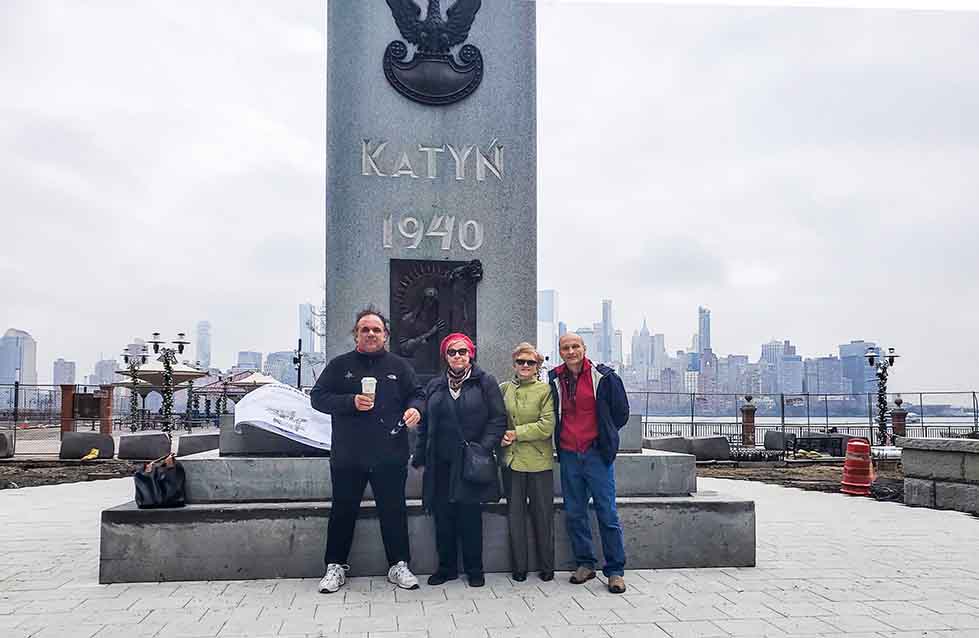
Last meeting with the director of the Exchange Place Alliance. Michael DeMarco - from the left, president Bogusława Huang, board member Regina Klimczuk and Wojciech Stan Mazur. (Source: KOPKiOH)
The lawsuit, with no visible results, has had a negative impact on our contacts with councilors and planners from the Exchange Place Alliance. They did not distinguish between us and did not want to have contact with people associated with the lawsuit. At the suggestion of the councilors, we had to issue a formal legal letter cutting us off from the lawsuit, to meet with Elizabeth Cain and Martin Schmidt and then Michel DeMarco, and to continue meeting with the councillors. I appeared in these conversations as an expert on plans, planning and construction processes, and all the tactical work of persuading our arguments was done by our wonderful Polish women, Bogusia, Regina and Iwona.
20% of the unaccepted demands that we complain about are the insertion of a wall with information about the monument in the middle of the opening from the city side. In this way, the access was divided into two passages. Nevertheless, we have an idea how to conduct the celebrations using a low wall as a tribune, and a similar idea was expressed by Consul Adrian Kubicki when I presented the course of negotiations to him. The consul's conclusion is as follows: despite the changes that are satisfactory to us, there will always be people who will not like it, de gustibus non est disputandum (Latin in matters of taste there can be no dispute – Ed.).
At a recent meeting with the director of the Exchange Place Alliance on January 6, our delegation made a tour of the square inspecting the pedestal and monument (no damage) and discussing further changes to the plans. A very important message was that the wall with information about the monument will not be as high as planned, and certainly will not cover the bas-relief with the Mother of God from September 11.
This information pleased us, because a 5-foot-high wall would be undesirable from an aesthetic point of view. DeMarco invited us to participate in the final phase of construction, proposing that we dedicate benches to people and organizations who contributed to the cause of the Katyn 1940 monument, and to edit an information board about the monument. The professional restoration and conservation of the monument will be paid for from the city's funds, and we are to choose the bushes for the flower beds ourselves and place them on the plans at our discretion.
MB: For today, with your hand on your heart, can you ensure that the future of the monument in this particular square and in this particular city is not in danger?
WSM: The works worth more than 7 million dollars are nearing completion and no one will demolish the square to remove a monument of such a large weight and size. This is contrary to municipal law and economic logic. We are also planning to apply for recognition of the monument as a landmark, so that it will be protected by the federal authorities. In the meantime, we intend to enter into an agreement with the city called "stewardship" to have full control over the planned moves and works in the future, and to make other small changes that we could not make now. This is our strategy, which we are slowly but surely implementing.
MB: Thank you.
Translation from Polish by Andrew Woźniewicz.



